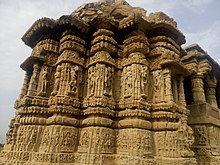| Rama Lakshamana Temple, Baradia | |
|---|---|
 Rama Lakshmana/Samba Lakshmana Temples Rama Lakshmana/Samba Lakshmana Temples | |
| Religion | |
| Affiliation | Hinduism |
| District | Devbhoomi Dwarka district |
| Deity | Rama, Lakshmana |
| Location | |
| State | Gujarat |
| Country | India |
 | |
| Geographic coordinates | 22°12′20″N 69°00′17″E / 22.20547°N 69.00483°E / 22.20547; 69.00483 |
| Architecture | |
| Type | Māru-Gurjara architecture |
| Completed | 12th century |
The Rama Lakshamana Temples or Samba Lakshamana Temples are the late 12th century twin Hindu temples in Baradia, a village in Okhamandal region of Devbhoomi Dwarka district, Gujarat, India. Baradia is about five km southeast of Dwarka. There are some temples near the coast within the limits of the village.
History
These temples were built in late 12th century during the reign of Bhima II of Chaulukya dynasty in Gujarat. These are the earliest extant Vaishnava temples in Gujarat. These temples are declared the Monuments of National Importance (N-GJ-125) and maintained by the Archaeological Survey of India.
Architecture

These are Maru-Gurjara or Solanki architecture temples standing on high moulded plinths (jagati). They are unicellular temples with four compartments; a cella, an antarala (between cella and hall), a sabhamandapa (hall) and a porch. There are no images of either Rama, Lakshmana, Samba or Lakshmana Kumara in the cella of these temples now. They are contemporary of Navlakha Temple, Ghumli, and have several similarities such as plinth and sculptures. Even sculptures of Brahma, Vishnu and Shiva are on the kumbha of bhadras, placed in similar fashion. In plan, they are similar to the Hindu temple at Sunak, Gujarat, except two free standing pillars of the porch.
The western temple facing east is very old and has well carved sculptures.
Other nearby temples of importance include the Sun temple, Chandrabhaga temple and a Bethak of Mahaprabhu.
Gallery
References
- ^ Haripriya Rangarajan (1990). Spread of Vaiṣṇavism in Gujarat Up to 1600 A.D.: A Study with Special Reference to the Iconic Forms of Viṣṇu. Somaiya Publications. pp. 12, 43, 141. ISBN 978-81-7039-192-0.
- ^ Dhaky, Madhusudan A. (1961). Deva, Krishna (ed.). "The Chronology of the Solanki Temples of Gujarat". Journal of the Madhya Pradesh Itihas Parishad. 3. Bhopal: Madhya Pradesh Itihas Parishad: 65.
- Pramod Chandra (1975). Studies in Indian Temple Architecture: Papers Presented at a Seminar Held in Varanasi, 1967. American Institute of Indian Studies. p. 128.
- Journal of the Asiatic Society. Vol. 15–19. Culcutta: Asiatic Society. 1973. p. 34.
- Krishna Deva; Lallanji Gopal; Shri Bhagwan Singh (1989). History and art: essays on history, art, culture, and archaeology presented to Prof. K.D. Bajpai in honour of his fifty years of indological studies. Ramanand Vidya Bhawan. p. 174. ISBN 9788185205458.
- Sompura, Kantilal F. (1968). The Structural Temples of Gujarat, Upto 1600 A.D. Gujarat University. p. 48. ISBN 9780861862450.
- ^ K. V. Soundara Rajan; Chedarambattu Margabandhu (1991). Indian archaeological heritage: Shri K.V. Soundara Rajan festschrift. Agam Kala Prakashan. p. 572.
- Desai, Shambhuprasad Harprasad (1977). Dwarka. Sorath Research Society. p. 46.



